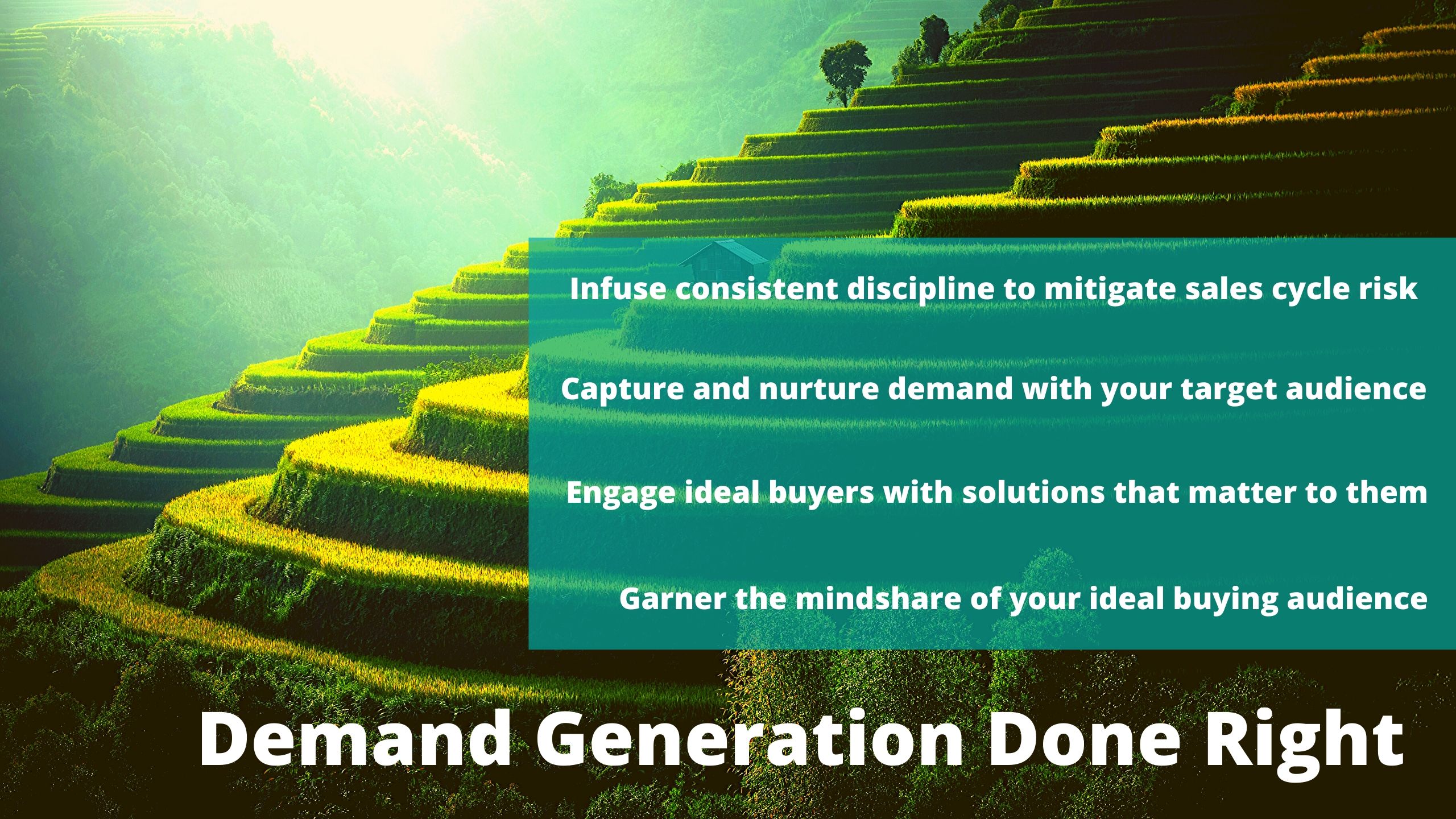Sustainable revenue performance ensures your organization is meeting its goals and finding its success not just here and now but into the future. Yet achieving profitable revenue year after year is no simple task. There is no golden egg solution. You will time and again meet internal and external challenges.
Yet with a well-oiled revenue engine, any challenges you come up against will be mitigated or side-stepped altogether.
At Mereo, we have developed a unique approach to revenue performance that leverages the inherently interdependent operational disciplines of demand progression, solution marketing, solution management, sales operations and sales enablement.
This week in the holistic revenue performance series, we will dive into demand progression and learn the greatest pitfalls affecting B2B organizations, how to overcome these and how this piece of the revenue performance Blueprint will help you win an unfair share of the market.
Discover your ideal buyer. Become their ideal solution.
Common Demand Progression Pitfalls
Demand issues often appear cut and dry. And in reality, the core of the issue is simple: The market demand for your solution is not meeting your projections to make it viable to continue providing the solution.
Diagnosing why this lack of demand exists, though, is not as simple as saying, “No one wants or needs your solution.”
There can be a number of reasons for low demand, with a number of causes both controllable and market-influenced.
Overall Lack of Leads
The phones are not ringing, nor are sales’ calls being answered. The email is full of messages, but they are from internal staff and your Seth Godin e-news subscription. This is a case of no demand. And with no demand for a solution, no need, there is rarely going to be a transaction or gain from either sellers or buyers. There can be many reasons for a lack of demand, from a poorly launched solution to a marketing effort full of activities and no actual strategic campaigns with purposeful target or end goals. The first step in understanding why you are struggling to generate demand is to diagnose what is blocking the funnel, what is the roadblock on the buyer’s journey. Is it that the buyers do not believe they have an issue worth solving? Or is it that they do not know you have a solution to their issue?
Missing the Goldilocks Zone of Leads
As sellers, we are always looking for buyers who are just right. Yet, some organizations never lay out what “just right” actually means. Is your ideal buyer an X company or a Y company? Does your marketing team know that? How about your sales team? What about your product teams? Without a formalized ideal buyer profile, marketing tends to keep stirring up demand as best as they can, which can create a pipeline full of unqualified opportunities salespeople cannot do anything with and that the product team does not have a solution.
Confusing or Misguiding Leads
If your product, sales and marketing teams are misaligned, you can bet that your target buyer has experienced confusion and possible frustrations in their buying journey — which virtually guarantees they will seek out and opt for an alternative to your solution. Likewise, with misalignment, your teams may suffer internal confusion of who the target buyer even is that either results in a lack of leads or a pipeline full of poor-quality leads.
Demand Progression Solutions to Win
While demand progression solutions vary on a case-by-case basis, there is a demand progression framework we lead from here at Mereo to provide selling organizations real results.
Audience Readiness
This is step one. Is your audience, your industry, your market prepared for the solution you have to offer? Is there a status quo you must overcome in order for your target to even consider your solution? Do they understand how it will work or integrate? How it will benefit them? Who you are and how you can deliver differently than any other competitor?
This phase is focused on:
- Understanding specific target pain points
- Building market awareness
- Managing market perception
- Fostering thought leadership and credibility
Demand Development
Once your audience is readied for your solution, it is important to leverage their interest and broad understanding to develop your leads. Marketing takes a lead role here, followed by salespeople reinforcing the value messaging and differentiation as it pertains to your target’s pains, needs and goals.
This phase focuses on:
- Deploying lead generation campaigns
- Implementing demand capture campaigns
- Holding sales discovery sessions
- Leveraging other lead nurturing capabilities
Sales Process Alignment
Lastly, your leadership team needs to have a strategy for delivering predictable profitable revenue. This means keeping a pulse on and optimizing the buying cycle, competitive environment and your very solution with your sales process and related activities. This process is not a once and done situation but rather something you should track and regularly review for further refinement to best achieve — and exceed — your revenue goals.
This phase focuses on:
- Aligning the sales process to the buying cycle
- Aligning the sales process to the competitive environment
- Aligning the sales process to the solution
Real Results Realized
Axway was transforming from a product provider to a subscription-based service without a formal plan in place for go-to-market success and organizational alignment. They were facing demand generation issues. They had to figure out how to align their fragmented organization around differentiated value messaging. They needed direction for leveling up their global sales teams and prepare them to close marketing-generated leads.
Mereo stepped in as the consulting partner. And with our solutions, we helped Axway realize organization-changing results. Learn more here.
AXWAY’S DEMAND GENERATION WINS

